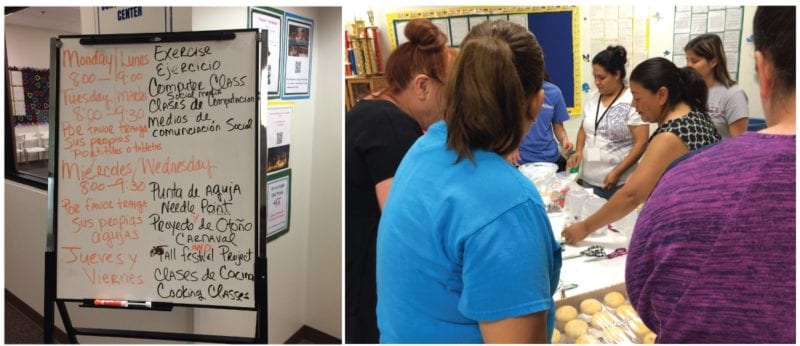Friendships can grow from a simple greeting. That’s why teachers, students, and administrators at Glen Ellyn School District 41 are encouraged to say hello.
Like many districts nationwide, District 41 has experienced an influx of immigrant families in recent years. Thanks to the presence of a World Relief branch in nearby Aurora/DuPage, this suburban Chicago district has become a haven for refugee families. Most newcomers speak Spanish, but many speak Vietnamese or Urdu, a language commonly used in India and Pakistan. District 41’s students and families speak a grand total of 54 different languages.
The district’s Say Hello campaign is the cornerstone of their efforts to welcome immigrant students and families. Posters that say “Start with Hello” and include the world hello in multiple languages adorn halls and classrooms. Teachers and staff wear T-shirts with the phrase “Start with Hello” to remind students to reach out.
https://www.facebook.com/glenellynd41/videos/1955341957821940/
“Our Say Hello campaign is meant to embrace all of the cultures across our school district,” says Katie McCluskey, assistant superintendent for teaching, learning, and accountability. “It focuses on the importance of inclusion for all.”
Here are six ways you can welcome newcomers from around the world:
1. Schedule a face-to-face getting-to-know-you meeting.
“Every child is unique. Just because two families look the same or come from the same place does not mean they have shared experiences,” says Katherine Brewer, head of school at The Village School in Houston, Texas. Some immigrant families have fled their home countries due to violence or oppression; others have come looking for economic opportunity. Some students were academic all-stars at home; others experienced interrupted schooling.
As soon as possible, schedule an in-person meeting. Be sure an interpreter is on hand. Use this meeting to share information about yourself and your class and to learn about the family’s history, needs, and communication preferences. Exhibit a “posture of curiosity and honor family’s migratory story,” advises Alina Ponce, a social worker who regularly works with immigrant families at the Momentous Institute in Dallas.
2. Bridge the language barrier.
“You cannot get to know somebody unless you speak the same language or you find someone who can translate,” Brewer says. Many schools use parent liaisons—school parents who share the same language or home country as newcomers—to bridge the communication gap. Others rely on in-house or contracted interpreters. If the family is comfortable with email, you may be able to use email and Google Translate for basic communications.
District 41 hires interpreters to help immigrant families through the registration process. “Most of our registration is online, so we’ll either have a parent liaison or interpreter sit with them and work through the process,” McCluskey says.
District 41 also offers bilingual and Spanish-only parent nights to go over basics such as testing schedules, grading, and device usage. Some districts post social media messages in multiple languages.
3. Incorporate diversity into your curriculum.

Brewer says that Village School educators have agreed to “leverage the diversity of ideas, perspectives, and people in our community to enrich our environment.” You can do the same by ensuring that your classroom library reflects a wide variety of human experiences. You can also weave lessons about immigration into your curriculum, with a focus on the contributions of people who came to your town from other countries. “Talk about shared values, such as hard work, family, dignity, and the desire for safety and stability,” Ponce says.
Teresa Shea, an ESL teacher at District 41’s Hadley Junior High, co-teaches science and social studies classes with content area specialists. She suggests grouping students heterogeneously, so they can learn from one another. “You might pair an English-speaking student who struggles with organization and staying on task with a language learner who excels in that area,” Shea says.
4. Provide resources for parents.

SOURCE: Momentous Institute
“Making the adults of a family comfortable is so important to a child’s success,” Brewer says. While schools can’t meet all the needs of immigrant families, educators can create important connections. The Momentous School in Dallas has a parents’ center—open to all school parents, immigrant or not—with a social services worker on staff; the staff member helps parents connect with community resources and plans educational programming to meet parents’ needs. “At one point, the group taught each other crafts and [was] sewing together,” Ponce says. “It’s a way to foster community.”
Momentous also hosts acculturation sessions to help parents understand the power hierarchies, communication strategies, and customs of American education.
In District 41, a bilateral parent advisory committee plans and hosts multiple parent engagement nights per year on topics suggested by immigrant parents. “We’ll have interpreters simultaneously interpreting during the presentation, so parents are understanding it in their first language,” McClusky says.
5. Engage students.
Students are great ambassadors. For one of their problem-based learning projects, a group of middle school students in District 41 tackled the question of how to make new arrivals to the United States feel more welcome. They surveyed current middle school students and ultimately created a video and pamphlet to share with new families. The video includes a tour of the school; introductions of the principal, vice principal, and some teachers; and a step-by-step guide on how to work the combination locks on the lockers. Now, administrators share the video with families when they come to register.
6. Assume positive intent.
“Different cultures have different expectations,” Shea says. “In some cultures, the parents don’t get involved in school unless they’re asked to by the teacher.”
Rather than jumping to conclusions, always assume positive intent. “All parents want their children to succeed,” Shea says.
We’d love to hear—what have you done to welcome immigrant students into your classroom or school? Come and share in our WeAreTeachers HELPLINE group on Facebook.
Plus, 10 things about childhood trauma every teacher needs to know.


